
Twitter has just announced a new feature that is sure to excite anyone who has been waiting for the site to offer an alternative to its Suggested User List. Appropriately called ‘Lists’, the new feature will allow anyone to make a list of other Twitter users and label it appropriately (for example, I could make a list called ‘TC Staff’), then share that list with other members. Twitter writes that the feature is still in limited testing, but that it will eventually be rolled out to all users.
By default any lists you create will be public, though you’ll also be able to hide them. If you choose to leave them publicly viewable, other Twitter users will be able to hit a button to “Follow this list” so they can add everyone at once. This is a big deal — until now the only convenient way to start mass following people on Twitter has been to use its own curated SUL. I won’t be surprised if we see some users vying to become the best ‘list makers’, offering comprehensive lists of celebrities, news portals, bloggers, and more. It will also be interesting to see if Twitter aggregates the most comprehensive Lists and includes them as part of the signup process (which would effectively just be the SUL in a different form).
Twitter’s post describing the new feature isn’t particularly detailed, but it seems like this may have a larger impact than just discovery — it could also potentially be used for Grouping, a feature that some third party apps have offered but that hasn’t been officially supported by Twitter. In short, this will let you group the people you follow into different list (say, one for News, one for close friends, and so on), and then quickly jump between them. Twitter will be supporting the new listing feature through its API, so we can likely expect this functionality to be extended to most third party applications that don’t already support grouping.
Also worth noting: a logical extension to grouping will be to support search within groups, which could help users weed out spam. Of course this is Twitter we’re talking about, so it could still be quite a while before we see this happen.
‘Lists’ may compete with sites like WeFollow that specialize in listing top Twitter users in various categories (on the other hand, these sites could actually become even more popular if they become the best places to find the most comprehensive Lists). It’s also likely going to replace TweepML, the open standard format for sharing groups of Twitter users.
Update: Twitter’s Jason Goldman clarifies that you do not have to follow everyone that you add to a list.